
If you have a struggling reader in your classroom, you already know how that student feels about reading anything out loud.
And yet, reading out loud is one of the best ways to improve students’ oral fluency.
For instance, within Imagine Language & Literacy, struggling readers gain confidence as they read and repeat text from leveled books and regularly participate in activities like Fluent Reader. What’s more, when teachers listen back to the recordings, they can easily track student progress toward oral fluency.
But Readers Theater can be another way to engage struggling readers and help them read aloud–with expression.
If all the world’s a stage, then every classroom can be transformed into a theater–in this case, a Readers Theater, which:

So, what makes a good script for Readers Theater–and how can you encourage students’ participatio
When it comes to scripts, remember this basic rule of thumb: always choose fun stories and characters. When students are having a good time imagining a dramatic situation or portraying an interesting character, they will feel less self-conscious about reading aloud.
If your students already use Imagine Language & Literacy, don’t forget to access the offline resources and printables within the Teacher Resources tab (after logging in as an educator).
Even if you don’t currently use the program, why not get started with one of these great options?
Remember, if you teach English language learners–including those whose first language is Spanish–you may find other fun options within Imagine Español. And–of course–you can even write your own Readers Theater scripts!
The point is, don’t be afraid to start. You’ll also find many Readers Theater scripts via simple online searches. Soon, your class will have a great time ‘learning out loud’!
Do you use Readers Theater as a classroom reading activity? Share your tips with us in the comments below.


